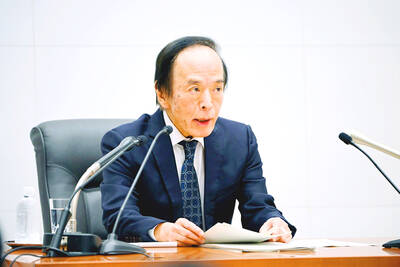The Directorate-General of Budget, Accounting and Statistics (DGBAS) yesterday revised downward its forecast for GDP growth this year to 3.03 percent from the 3.38 percent it estimated last month, mainly due to weaker exports.
It was the sixth straight time DGBAS has revised downward its forecast for this year’s GDP growth since August last year, when the agency forecast a 4.58 percent growth rate for this year.
“Exports fell more than expected in the first half of the year, which is the major factor making us revise downward our full-year economic growth forecast,” DGBAS section chief Joshua Gau (高志祥) told a press conference.
Exports dropped 4 percent in the first quarter from a year earlier, a phenomenon rarely seen, Gau said.
Previous drops in quarterly exports only happened during the Asian financial crisis that began in 1997, the dot-com bubble in 2000 and the global financial crisis that began in 2008.
Full-year exports are expected to grow 2.69 percent to US$316.5 billion this year, with exports in the second quarter continuing to post a 2.55 percent year-on-year decline, DGBAS statistics showed.
The agency also revised downward its forecast for private consumption this year to 2.03 percent from the 2.28 percent estimated last month, citing the negative impact of the recent volatile stock market and rising inflationary pressure.
First-quarter economic growth stood at 0.39 percent, the lowest level in more than two years and a deceleration from the 1.85 percent in the fourth quarter of last year, DGBAS said.
Katrina Ell, a Sydney-based economist at Moody’s Analytics, said electronics are the key weak point, dragging down manufacturing and exports, and flowing through to private consumption.
“Production and exports face severe headwinds due to weak global technology demand,” Ell said in a research note yesterday.
She expects weakness to continue into the second quarter, because global technology demand has remained soft, before the economy strengthens in the second half of the year.
The latest DGBAS data also showed GDP growth is expected to expand gradually to 0.77 percent in the second quarter, 4 percent in the third quarter and 6.55 percent in the fourth quarter.
The government’s decision to increase electricity rates in three stages, instead of the original one-time bump, has helped lessen the negative impact on GDP growth this year, DGBAS statistics division director Tsai Hung-kun (蔡鴻坤) said.
The rise in electricity and gas prices under the new plan is expected to drag down economic growth this year by 0.24 percentage points, down from the original plan’s 0.34 percentage point impact, Tsai said.
The new plan is also expected to have less impact on annual growth in the consumer price index (CPI), allowing the DGBAS to revise downward its CPI growth forecast to 1.84 percent for this year, compared with its previous estimate of 1.94 percent.

Taiwan’s long-term economic competitiveness will hinge not only on national champions like Taiwan Semiconductor Manufacturing Co. (TSMC, 台積電) but also on the widespread adoption of artificial intelligence (AI) and other emerging technologies, a US-based scholar has said. At a lecture in Taipei on Tuesday, Jeffrey Ding, assistant professor of political science at the George Washington University and author of "Technology and the Rise of Great Powers," argued that historical experience shows that general-purpose technologies (GPTs) — such as electricity, computers and now AI — shape long-term economic advantages through their diffusion across the broader economy. "What really matters is not who pioneers

In a high-security Shenzhen laboratory, Chinese scientists have built what Washington has spent years trying to prevent: a prototype of a machine capable of producing the cutting-edge semiconductor chips that power artificial intelligence (AI), smartphones and weapons central to Western military dominance, Reuters has learned. Completed early this year and undergoing testing, the prototype fills nearly an entire factory floor. It was built by a team of former engineers from Dutch semiconductor giant ASML who reverse-engineered the company’s extreme ultraviolet lithography (EUV) machines, according to two people with knowledge of the project. EUV machines sit at the heart of a technological Cold

TAIWAN VALUE CHAIN: Foxtron is to fully own Luxgen following the transaction and it plans to launch a new electric model, the Foxtron Bria, in Taiwan next year Yulon Motor Co (裕隆汽車) yesterday said that its board of directors approved the disposal of its electric vehicle (EV) unit, Luxgen Motor Co (納智捷汽車), to Foxtron Vehicle Technologies Co (鴻華先進) for NT$787.6 million (US$24.98 million). Foxtron, a half-half joint venture between Yulon affiliate Hua-Chuang Automobile Information Technical Center Co (華創車電) and Hon Hai Precision Industry Co (鴻海精密), expects to wrap up the deal in the first quarter of next year. Foxtron would fully own Luxgen following the transaction, including five car distributing companies, outlets and all employees. The deal is subject to the approval of the Fair Trade Commission, Foxtron said. “Foxtron will be

INFLATION CONSIDERATION: The BOJ governor said that it would ‘keep making appropriate decisions’ and would adjust depending on the economy and prices The Bank of Japan (BOJ) yesterday raised its benchmark interest rate to the highest in 30 years and said more increases are in the pipeline if conditions allow, in a sign of growing conviction that it can attain the stable inflation target it has pursued for more than a decade. Bank of Japan Governor Kazuo Ueda’s policy board increased the rate by 0.2 percentage points to 0.75 percent, in a unanimous decision, the bank said in a statement. The central bank cited the rising likelihood of its economic outlook being realized. The rate change was expected by all 50 economists surveyed by Bloomberg. The